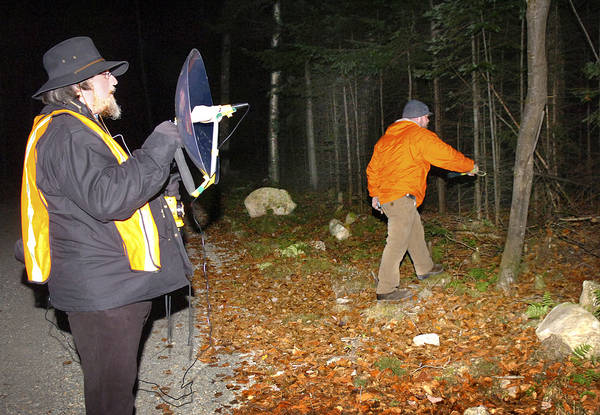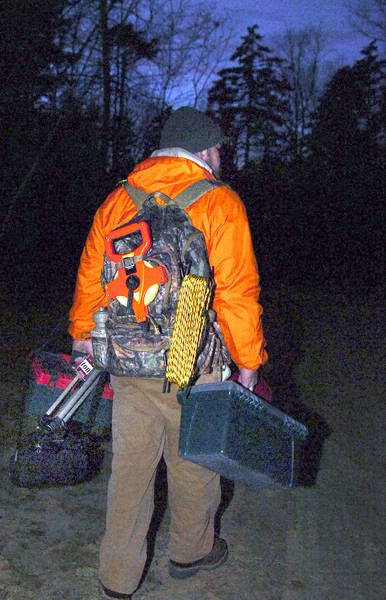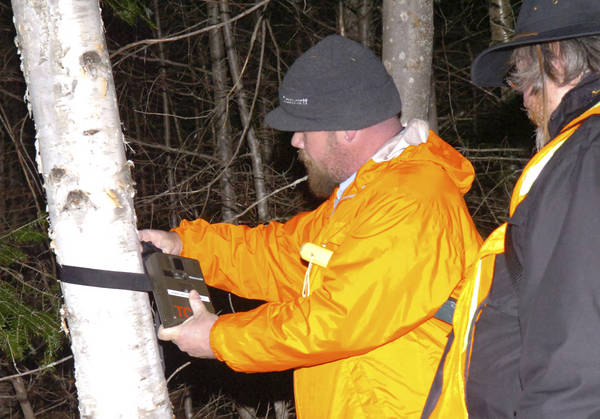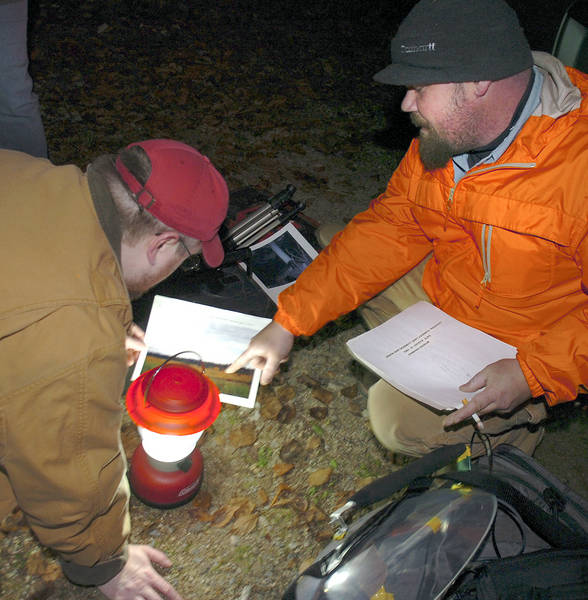
December 1, 2007

Vladika Michael of Bangor holds a parabolic listening device as Chris Julian of Enfield bangs a thick stick against a tree as they look for signs of Bigfoot in the woods of Rangeley Plantation. The idea is if Bigfoot is out there, he may knock back. (Russ Dillingham/Sun Journal)
For more than a mile, the forest on both sides of the closed-up camp road was quiet except for the white noise of wind coming off Mooselookmeguntic Lake. Walking along in the dark, Chris Julian explained why he keeps his investigations secret (the risk of pranks), what he carries in his bag (human pheromones) and his general thoughts on out-of-state researchers (opportunistic jerks).
Suddenly one tree, one lone tree among thousands, let loose with an obscenely creepy, creaky whine, something between a coffin lid and a sticky farmhouse door.
Everyone stopped to listen and stare.
Could Bigfoot be leaning against the tree? Could he be up in the tree?
Someone shone a light. No Bigfoot, yet still it creaked, and whined and pleaded, that one tree in the whole wide woods. The sound was an eerie reminder that we were in the middle of pitch-black-nowhere with no cell reception, no one else for miles, looking for a hairy, elusive thing seven-feetish tall, spotted in these same woods.
Creeeeaaaakkkkkk.
Julian does this most weekends, and, yeah, he gets scared. Minutes before, he’d told a buddy:
“I feel good about this area. … As long as we don’t become food, we’re good.”
* * *
Julian’s been looking for Bigfoot since 1993. He got hooked as a kid.
“My father took me to see a movie, ‘The Legend of Bigfoot.’ It actually scared the hell out of me,” he said. He read every published report and book he could find and eventually, frustrated there wasn’t more out there about his home state, founded Maine Bigfoot Research.
It’s got 25 members, 10 of whom regularly join him in the woods, including a retired police chief from Massachusetts.
“Nobody ever directly looked in Maine, solely in Maine. That’s my deal,” Julian said.
The self-employed carpenter lives in Enfield, above Bangor. A couple times a year he puts an ad in Uncle Henry’s looking for interested members or sightings to investigate.
Julian makes it clear: He’s never seen one. The 35-year-old bristles a bit at others who supposedly know what Bigfoot likes or doesn’t like, and his habits. An outsider would be shocked at the jockeying that goes on in the Bigfoot arena: Researcher A is skeptical of Researcher B, who flat out despises Researcher C.
“I could give a rat’s ass about chupacabra, Loch Ness, all that. … I care about Maine Bigfoot, you know, and this attitude is why I have so many friends in this field,” Julian said, chuckling.
* * *
Turns out a Bigfoot scouting expedition takes a lot of gear. On a chilly Saturday evening in November, Julian and two prospective group members set off up an enormous hill, into the woods, laden with supplies.
Joe McGouldrick of Lowell, a high school freshman, thinks Bigfoot might be real. Vladika Michael of Bangor, a Russian Orthodox priest in Maine to build a monastery, called himself an “open-minded eternal skeptic.”

Chris Julian carries some of the equipment needed in the search for Bigfoot, which includes a tackle box with flares and a boombox to broadcast Bigfoot sounds. The motto for his group, Maine Bigfoot Research: “Solving this mystery one step at a time.” (Russ Dillingham/Sun Journal)
The three carry a camera tripod, a tackle box with flares, a parabolic (super-sensitive) microphone, a lantern, a boombox to broadcast Bigfoot sounds, a duffel bag with a motion-sensitive trail cam and a backpack with thick rope and orange tent stakes hanging off the side.
When asked, Julian didn’t want to explain the rope; we’d probably laugh. Later, he elaborated: one reason is for safety, the other is to set traps.
The area is remote: 33 miles above Rumford in Rangeley Plantation, specifically a spot known as Bemis. On flat ground a quarter-mile in, Julian set down all the equipment and turned on the lantern.
In 2004 a zoology student and her friend told BigfootEncounters.com they saw Bigfoot at a campsite just off this road.
“There’s been two (sightings) that I know of, this being one of them, of one actually being seen in the water,” he says. “In the night, they saw shadows all around the campsite. It made a beeline for the water. … We have pretty boring sightings in Maine, really. That was one of the more spectacular ones.”
Julian has collected reports of more than 56 sightings. Presque Isle is the current hot spot; he’s going up there in the spring. But this region has promise, he says. In 2006, a truck driver claimed three Bigfoot crossed the road in front of him in Canton. Andover’s had quite a few reports. The miles between here and there are covered with dense, hide-behind-able trees.
* * *
It gets darker, darker, darker and eventually McGouldrick turns on a head lamp, illuminating the way about 15 feet at a time. The woods are noiseless, and every so often Julian stops to bang a thick stick against a tree; it’s called knocking. The idea is, if Bigfoot’s out there, he may knock back.
He doesn’t. But all the same, it’s creepy to stand there, listening. A couple times there are faint noises in the woods, nothing anyone can see or explain. Could have been a mouse, a twig.
Julian’s a little disappointed. Washed out roads meant he couldn’t arrive early and scout the forest himself for tracks or at least make sure it was safe to lead everyone off the camp road and into the woods.
The highlight of the two-hour scouting trip: The motion-sensitive trail cam snapped two photos while everyone was away. What passed in front of it? There’s speculation all through the group. (Later, on his computer, Julian finds that both photos are pure black. The camera could have been tripped by a leaf.)

Chris Julian attaches a motion-sensitive camera to a tree that he hopes can snap a picture of Bigfoot, should he walk past. (Russ Dillingham/Sun Journal)
Maine’s got the right habitat for Bigfoot, Julian says, quickly correcting himself: Maine has what could be the right habitat. The state has as good a chance as any of being the site of that ultimate Bigfoot discovery.
Walking along in the dark, he’s pretty certain: “Someday somebody’s going to find it. I’m just hoping it’s me.”
Back at the minivan, McGouldrick said he had fun. Michael did, too. And if the group had spotted one on this, his first night, he said, he’d be extra skeptical.Kathryn Skelton, Staff Writer
Lewiston Sun Journal, December 1, 2007.

Chris Julian, right, points out photos sent by people who claim to have seen signs of Bigfoot in Maine. (Russ Dillingham/Sun Journal)
About Loren Coleman
Loren Coleman is one of the world’s leading cryptozoologists, some say “the” leading living cryptozoologist. Certainly, he is acknowledged as the current living American researcher and writer who has most popularized cryptozoology in the late 20th and early 21st centuries.
Starting his fieldwork and investigations in 1960, after traveling and trekking extensively in pursuit of cryptozoological mysteries, Coleman began writing to share his experiences in 1969. An honorary member of Ivan T. Sanderson’s Society for the Investigation of the Unexplained in the 1970s, Coleman has been bestowed with similar honorary memberships of the North Idaho College Cryptozoology Club in 1983, and in subsequent years, that of the British Columbia Scientific Cryptozoology Club, CryptoSafari International, and other international organizations. He was also a Life Member and Benefactor of the International Society of Cryptozoology (now-defunct).
Loren Coleman’s daily blog, as a member of the Cryptomundo Team, served as an ongoing avenue of communication for the ever-growing body of cryptozoo news from 2005 through 2013. He returned as an infrequent contributor beginning Halloween week of 2015.
Coleman is the founder in 2003, and current director of the International Cryptozoology Museum in Portland, Maine.
Filed under Bigfoot, Breaking News, Cryptotourism, CryptoZoo News, Cryptozoologists, Cryptozoology, Eyewitness Accounts, Sasquatch, Windigo